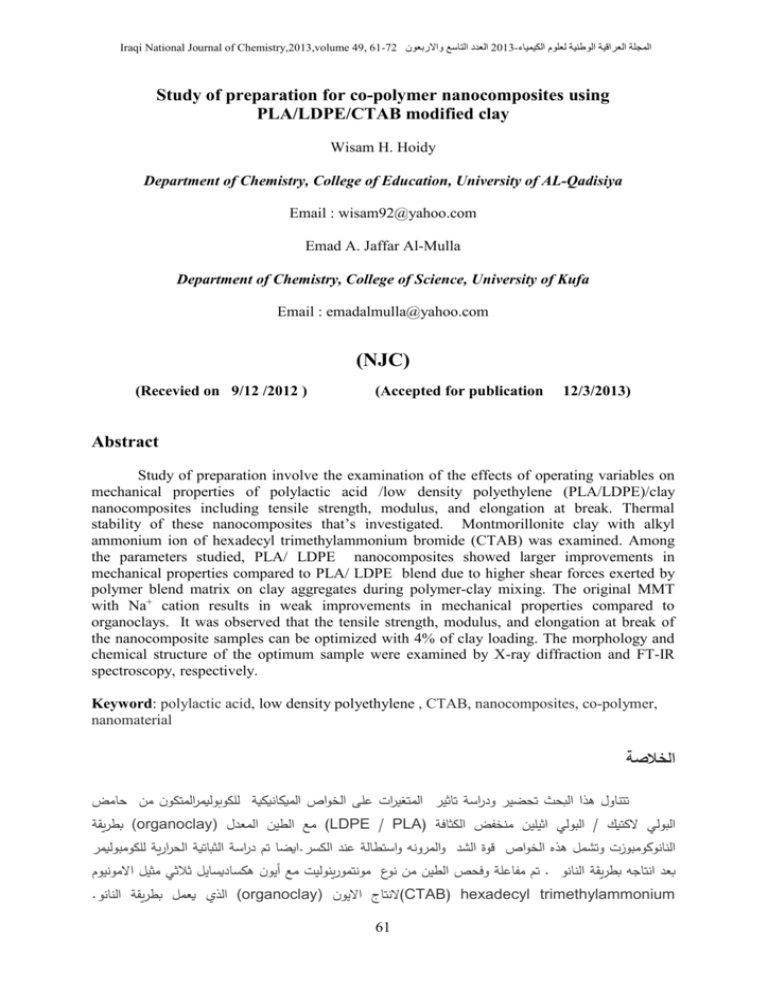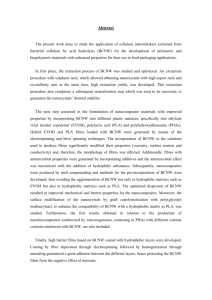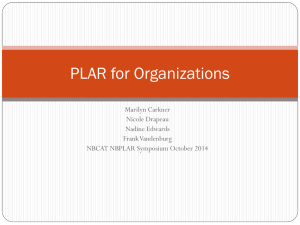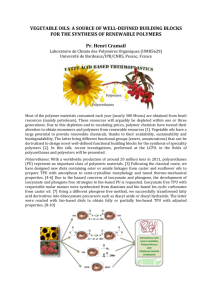With the increasing public attention to environmental problems, the
advertisement

Iraqi National Journal of Chemistry,2013,volume 49, 61-72 العدد التاسع واالربعون1023-المجلة العراقية الوطنية لعلوم الكيمياء Study of preparation for co-polymer nanocomposites using PLA/LDPE/CTAB modified clay Wisam H. Hoidy Department of Chemistry, College of Education, University of AL-Qadisiya Email : wisam92@yahoo.com Emad A. Jaffar Al-Mulla Department of Chemistry, College of Science, University of Kufa Email : emadalmulla@yahoo.com (NJC) (Recevied on 9/12 /2012 ) (Accepted for publication 21/3/2013) Abstract Study of preparation involve the examination of the effects of operating variables on mechanical properties of polylactic acid /low density polyethylene (PLA/LDPE)/clay nanocomposites including tensile strength, modulus, and elongation at break. Thermal stability of these nanocomposites that’s investigated. Montmorillonite clay with alkyl ammonium ion of hexadecyl trimethylammonium bromide (CTAB) was examined. Among the parameters studied, PLA/ LDPE nanocomposites showed larger improvements in mechanical properties compared to PLA/ LDPE blend due to higher shear forces exerted by polymer blend matrix on clay aggregates during polymer-clay mixing. The original MMT with Na+ cation results in weak improvements in mechanical properties compared to organoclays. It was observed that the tensile strength, modulus, and elongation at break of the nanocomposite samples can be optimized with 4% of clay loading. The morphology and chemical structure of the optimum sample were examined by X-ray diffraction and FT-IR spectroscopy, respectively. Keyword: polylactic acid, low density polyethylene , CTAB, nanocomposites, co-polymer, nanomaterial الخالصة تتناول هذا البحث تحضير ودراسة تاثير المتغيرات على الخواص الميكانيكية للكوبوليمرالمتكون من حامض ( بطريقةorganoclay) ) مع الطين المعدلLDPE / PLA( البولي اثيلين منخفض الكثافة/ البولي الكتيك ايضا تم دراسة الثباتية الح اررية للكومبوليمر.النانوكومبوزت وتشمل هذه الخواص قوة الشد والمرونه واستطالة عند الكسر تم مفاعلة وفحص الطين من نوع مونتمورينوليت مع أيون هكساديسايل ثالثي مثيل االمونيوم. بعد انتاجه بطريقة النانو .( الذي يعمل بطريقة النانوorganoclay) )النتاج االيونCTAB( hexadecyl trimethylammonium 61 Iraqi National Journal of Chemistry,2013,volume 49 العدد التاسع واالربعون1023-المجلة العراقية الوطنية لعلوم الكيمياء نانوكومبوزت ان هنالك تحسن كبير في الخواص الميكانيكية والح اررية كماPLA/LDPE اضهرت النتائج على دراسة (organoclay) لوحده حيث ان الطين المعدلPLA/LDPE والتنسايل والمرونه مقارنة بمزيجTGA ظهر في فحص كما تمت مالحظة ان قوة الشد التنسايل واالستطارة قد ازدادت بوجود. المضاف حسن من قوة تحمل البوليمرللح اررة والشد ايضا تم فحص التركيب. %4 فيما قلت هذه الخواص عند زيادة النسبة عن%4 الطين المعدل المضاف بمعدل ايضا تمXRD وFTIR من الطين المعدل بواسطة%4 الكيميائي والمورفولوجي للناتج للعينة االمثل المضاف لها .TEM وSEM اخذ صور للناتج الضهار النانو بواسطة flexural strength also decreased with increasing content of MMT in PLA/LLDPE nanocomposites. The impact strength and elongation at break of LLDPE toughened PLA nanocomposites also declined steadily with increasing loadings of MMT [12] . Introduction Public attention has been increased into environmental problems, the research of biodegradable polymers has gained considerable momentum in recent years [1,2] . Polylactic acid (PLA) is the most popular commercial biodegradable polymers that have found wide applications, especially in the biomedical applications [3-5]. However, PLA has some disadvantages that restrict their practical applications. For instance, PLA has high strength. melting temperature, slow degradable, hard, and brittle [6].The main limitations of these biodegradable polymers towards their wider industrial application are their poor thermal, mechanical resistance and limited gas barrier properties, which limit their access to industrial sectors, such as packaging, in which their use would be justified when biodegradability is required [7,8]. Many attempts have recently been made to improve the mechanical properties of PLA through fabrication of blends with other polymers and composite materials with clay or natural fibers [9-11]. For example, Yuan and Ruckenstein found that toughness of PLA can be improved by blending a proper amount of polyurethane and a proper extent of cross-linking . Park and Im suggested that toughness of PLA/starch blend can be improved by using gelatinized starch as dispersed phases mainly owing to improvement of the interfacial adhesion. LLDPE improved the impact strength of PLA nanocomposites with a sacrifice of tensile and flexural strength. The tensile and Previous researchers have shown that addition of plasticizers such as polyethylene glycol (PEG), glucosemonoesters and partial fatty acid esters had successfully overcome the brittleness and widen PLA’s application [13] . Previous study also shown performed melt blending of PLA and LLDPE in an effort to toughen PLA showed that semicrystalline PLA has relatively good miscibility with LLDPE, hence these two materials are chosen as matrix and impact modifier. The researchers also reported a significant increase of impact strength in semicrystalline PLA with the addition of LLDPE and stated that they had successfully toughen PLA with LLDPE[14]. However, the researchers had only investigated the effect of 20 wt.% LLDPE with PLA and the study focused on the compatibility of LLDPE in semicrystalline PLA. Polymer/clay nanocomposites have received significant attentions from both academic and industrial area in recent years due to the excellent enhancement in physical and/or chemical properties relative to the neat polymer matrix [15]. The polymer/clay nanocomposites is prepared by the intercalation of monomers or 62 Iraqi National Journal of Chemistry,2013,volume 49 العدد التاسع واالربعون1023-المجلة العراقية الوطنية لعلوم الكيمياء polymers into swellable layered silicate hosts. In most cases, the synthesis involves either melt-direct polymer intercalation by using a conventional polymer extrusion process or intercalation of a suitable monomer and then exfoliating the layered host into their nanoscale elements by subsequent polymerization [16,17]. The high aspect ratio layered silicate affects the mechanical, physical and thermal properties of the synthesizing polymer/clay nanocomposites [18]. solution. Designated amount of sodium montmorillonite (Na-MMT) was stirred vigorously in 600 ml of hot distilled water for one hour to form a clay suspension. Subsequently, desired amount of surfactant (CTAB) which had been dissolved in 400 ml of hot water and desired amount of concentrated acid hydrochloride (HCl) was added into the clay suspension of (CTAB). After stirred vigorously for one hour at 80 °C. The organoclay suspension was filtered and washed with distilled water until no chloride was detected with 1.0 M silver nitrate solution. It was then dried at 60 °C for 72 hours. The dried organoclay (CTAB-MMT) was ground until the particle size was less than 100 μm before the preparation of nanocomposite. In this paper, we report the preparation and characterization PLA/LDPE-CTAB-MMT to produce nanocomposites using organoclay. CTAB was employed to modify Na-MMT. Characterization of nanocomposites was done by various apparatuses. Preparations of PLA/PE –clay nanocomposites by melt blending Experimental The designed amount of PLA/LDPE ratio were prepared by an internal mixer (Haake Polydrive), using different conditions (temperature, speed and time) in order to obtain the optimum conditions which were 185 °C, 50 rpm and 12 minutes ,respectively. To prepare a sample of the composite, a specific amount of PLA was first melted and mixed thoroughly with appropriate amount of LDPE for 2 minutes. Various amounts of organoclays (1, 2, 3, 4, 5 and 6 phr) were incorporated into the blend in the third minute. The mixture was compressmoulded into sheet of 1 mm thickness sheets under a pressure of 100 kgcm-1 in a standard hot press at 150 °C for 15 min, and cooled pressed process for 10 minutes to obtain a good blend film. The amount of PLA,LDPE and the organoclays used are listed in Table 1 Materials Sodium montmorillonite was Kunimine Ind. Co. Japan. Cetyl trimethylammonium bromide was from Acros Organics, USA. Polylactic acid was purchases from Japan. Polyethylene was obtained from Solvay Caprolactone, Warrington, England. Hydrochloric acid HCl was from Sigma – Aldrich, Germany. (All experiments and tests were completed at the University of UPM in Malaysia) Preparation of Organoclay Organoclay was prepared by cationic exchange process where Na+ in the montmorillonite was exchanged with alkylammonium ion in an aqueous 63 Iraqi National Journal of Chemistry,2013,volume 49 العدد التاسع واالربعون1023-المجلة العراقية الوطنية لعلوم الكيمياء Table 1: The amount of PLA/PE and organoclay for melt blending Weight of PLA Weight of PCL Sample Identity 8PLA 2LDPE 8PLA 2LDPE mod1 8PLA 2LDPE mod2 8PLA 2LDPE mod3 8PLA 2LDPE mod4 8PLA 2LDPE mod5 8PLA 2LDPE mod6 8PLA 2LDPE mod7 8PLA 2LDPE mod9 Characterization (g) 32.00 31.68 31.36 31.04 30.72 30.40 30.08 29.76 29.12 Weight of Organoclay (g) 8.00 0.00 7.92 0.40 7.84 0.80 7.76 1.20 7.68 1.60 7.60 2.00 7.52 2.40 7.44 2.80 7.28 3.60 SEM the fractured surfaces of the nanocomposites were studied using a JEOL attached with Oxford Inca Energy 300 EDXFEL scanning electron microscope operated at 20 to 30 KV. The scanning electron micro photographs were recorded at a magnification of 1000X to 3000X. SEM analysis was carried out to investigate polymer splitting, polymer pull-out, debonding, matrix cracking and polymer matrix adhesion. Samples were dehydrated for 45 minutes before being coated with gold particle using SEM coating unit Baltec SC030 sputter coater. The FTIR spectra were recorded on Perkin Elmer FTIR 1650 spectrophotometer at ambient temperature using a KBr disk method. The disk containing 0.0010 g of the sample and 0.3000 g of fine grade KBr was scanned at 16 scans at wavenumber range of 4004000 cm-1 Elemental analyser (LECO CHNS932) was used for quantitative analysis of amount of intercalation agent present in the organoclay. A sample of approximately 2 mg of organocly burned at 1000°C under oxygen gaseous flow was used for this test. The sulfamethazine was used as standard. The dispersion of clay was studied by using Energy Filtering Transmission Electron Microscopy (EFTEM). TEM pictures were taken in a LEO 912 AB Energy Filtering Transmission Electron Microscope with an acceleration voltage of 120 KeV. The specimens were prepared using a Utracut E (Reichert and Jung) cryomicrotome. Thin sections of about 100 nm were cut with a diamond knife at - 120 ºC. X-ray Diffraction (XRD) study was carried out using shimadzu XRD 6000 diffractometer with Cu-K radiation (λ = 0, 15406 nm). The diffractogram was scanned in the ranges from 2-10° at a scan rate of 1° min-1. TG analysis using Perkin Elmer model TGA 7 Thermogravimetric analyzer was used to measure the weight loss of the samples. The samples were heated from 30-800°C with the heating rate of 10°C min-1 under nitrogen atmosphere at the flow rate of 20 ml min-1. Results and Discussion Fourier transform spectroscopy infrared (FTIR) The FTIR spectra of PLA/LDPE blends are shown in Figure1 b. The peaks located at 2995, 2944, and 1749 cm-1. The 64 Iraqi National Journal of Chemistry,2013,volume 49 العدد التاسع واالربعون1023-المجلة العراقية الوطنية لعلوم الكيمياء FTIR spectra of the CTAB-MMT, PLA/PE and PLA/PE nanocomposites are shown in Figure 1. The spectrum of PLA/LDPE nanocomposites shows the peak at 3301 cm-1 is due to the N-H amide. The peaks at 2945 cm-1 and 2890 cm-1 are due to the C- H stretching. The peak for C=O bending absorbed at 1748 cm-1. The peak for C-O bending is at 1183 cm-1. The peak for Si-O stretching is at 400 cm-1. Therefore, these indicate that CTAB-MMT are intercalated with polymers. [19]. Figure 1. FTIR spectra of (a) CTAB-MMT, (b) PLA/LDPE and (c) PLA/LDPE-CTAB-MMT the thermal stability of organic materials [20] . Thermogravimetric analysis TGA Thermogravimetric analysis (TGA) is a quantitative measurement of mass change for a material exposed to a controlled temperature program. It also records the temperature of the weight loss region and the maximum temperature of decomposition. TGA detects single or multiple loss steps from room temperature to 1000 C. This measurement was done to determine the thermal stability of the sample. The sample mass loss due to the volatilizations of degraded by-product is monitored as a function of a temperature. Inorganic materials are more thermally stable and resistance compared to the organic material. Thus introduction of inorganic particles would greatly improve Figure2 (a) shows the decomposition of PLA/LDPE starts at around 250.8ºC and completes at 299.1 ºC a single peak at 274.5°C Figure2 b, shows the TGA thermogram of PLA/LDPE- MMT nanocomposites. The degradation temperature of the nanocomposites increase with the adding of MMT to the PLA/PE blend, the decomposition of PLA/LDPE - MMT nanocomposites starts at around 258.7°C and completes at 306.1°C the single peak at 282.2°C. Figure 2 c shows the TGA thermogram of PLA/LDPE-CTAB-MMT nanocomposites. The degradation temperature of the 65 Iraqi National Journal of Chemistry,2013,volume 49 العدد التاسع واالربعون1023-المجلة العراقية الوطنية لعلوم الكيمياء nanocomposites increase with the adding of CTAB-MMT to the PLA/LDPE blend, the decomposition of PLA/LDPE-CTABMMT nanocomposites starts at around 291.2°C and completes at 340.3 °C a single peak at 315.1 °C. The temperature of the main degradation is shifted towards a higher value when OMMT is used compare to the pristine composite, it could be observed that organophilic treatment improves the thermal stability of PLA/LDPE nanocomposites due to better interaction between PLA/PE matrix and clay. Incorporated of the MMT, CTABMMT in PLA/LDPE improves slightly the composites thermal stability. The increase in thermal stability of PLA/LDPE-MMT and PLA/LDPE-CTAB-MMT nanocomposites may result from the dispersion of the clay and from a strong interaction between the clay platelets and the polymer matrix [21]. Figure2. TGA thermogram of (a) PLA/LDPE , (b) PLA/LDPE-MMT and (c) PLA/LDPE-CTAB-MMT X-ray diffraction XRD spacing. The above findings indicate that there is intercalation of PLA/LDPE into the interlayers of the organoclay prepared melt blending. Increase the organoclay content decrease the basal spacing interlayer spacing this because increase the organoclay content will reduce the amount of the polymer intercalated in the galleries of the silicate layers [22]. These can be also related to the surface accessibility where the closer packing of the silicate layers is more difficult for the polymer chains to penetrate. Based on the above results, intercalated nanocomposites were prepared in this study. The XRD pattern of MMT and CTAB-MMT show peak 2θ of 7.35 and 4.64 which correspond to the basal spacing 12.2 and 19.32 Å, respectively. (Figure3, Table2). XRD of PLA/LDPE-CTABMMT nanocomposites with 1,2,3,4,5and 6 phr of CTAB-MMT show shift to lower angles between 2θ of 3.73- 3.35 correspond to the basal spacing between 24.04 -26.76°A ( Figure 4, Table 3). It is found that PLA/LDPE- CTAB-MMT nanocomposites with organoclay in melt blending loading 4% give the highest basal 66 Iraqi National Journal of Chemistry,2013,volume 49 العدد التاسع واالربعون1023-المجلة العراقية الوطنية لعلوم الكيمياء Table 2: Diffraction angle and basal spacing of montmorillonite and modified montmorillonite with CTAB Sample Montmorillonite 2θ ( ° ) 7.35 d(001) spacing (Å) 12.2 CTAB modified 4.64 19.32 Figure 3. The XRD patterns of (a) Na-MMT (b) CTAB-MMT 67 Iraqi National Journal of Chemistry,2013,volume 49 العدد التاسع واالربعون1023-المجلة العراقية الوطنية لعلوم الكيمياء Figure 4. XRD patterns of PLA/LDPE with various ratio of CTAM-MMT Table 3: XRD of PLA/PE- CTAB-MMT 2θ (degree) d001-spacing (Å) 3.73 24.04 3.50 25.62 3.47 25.84 3.35 26.76 3.45 25.99 3.39 26.45 layered silicates. The tensile strengths of hybrid films with different OMMT contents are shown in Figure 5. The Figure The best ratio of tensile strength shows that low contents of OMMT (4 and modulus properties of PLA/LDPE wt%) was best ratio of organoclay. Further blending was 80/20 [23]. Therefore, the increase of the CTAB-MMT content does ratio of 80/20 was used for further not significantly change the tensile experiments. strength of the blend. At the higher clay concentration, the organoclay is not The tensile properties of polymeric homogenously distributed in the matrix. materials can be improved in different The agglomeration of the clay causes degrees if nanocomposites are formed with phase separation [24]. Organoclay content 1% 2% 3% 4% 5% 6% Tensile strength 68 Iraqi National Journal of Chemistry,2013,volume 49 العدد التاسع واالربعون1023-المجلة العراقية الوطنية لعلوم الكيمياء Figure 5. Tensile strength of 80PLA20LDPE, with various contents of CTAB-MMT affects the morphology, and thus also the fraction behaviour of PLA/LDPE nanocomposites which indicate the OMMT flow homogenous in the matrix and form smaller void size. This reveals that the presence of OMMT as a filler enhanced the dispersion and interfacial adhesion of polymer matrix. This observation is agreement with the higher value of tensile strength during tensile test when OMMT is added into composites. Scanning electron microscopy (SEM) Figure 6 shows the SEM images of PLA/LDPE blends and PLA/LDPE with 4% CTAB-MMT in the same scale 10 μm. LDPE was located inside of the empty voids of the PLA continuous phase. It can be seen that the distribution of LDPE in the PLA matrix is homogenous and form single phase morphology (Figure 6a). Figure 6b shows PLA/LDPECTAB-MMT morphology. The incorporation of CTAB-MMT strongly 69 Iraqi National Journal of Chemistry,2013,volume 49 العدد التاسع واالربعون1023-المجلة العراقية الوطنية لعلوم الكيمياء (a) (b) Figure 6. SEM micrographs of (a) PLA/LDPE, (b) PLA/LDPE 4% CTAB-MMT earlier. This could be the possible reason for the drop in the impact strength observed for PLA/LDPE with 4 phr of OMMT. The decrease in impact strength, however, was not severe due to the well dispersed LDPE particles which compensated the loss of toughness due to agglomeration of OMMT. Transmission electron microscope (TEM) Figure 7a illustrates the TEM micrographs of PLA/LDPE pure while in Figure 7b The TEM images of PLA/LDPE/4% CTAB-MMT revealed that the OMMT layers had aggregated at 4 phr OMMT content consistent with XRD analysis Figure7. TEM micrographs of (a) PLA/LDPE, (b) PLA/LDPE 4% CTAB-MMT could be used to synthesize PLA/LDPE clay nanocomposites. The silicate layers of the clay were intercalated distributed in the matrix. The addition of OMMT to the PLA/LDPE blend significantly improved the tensile properties of nanocomposites. The highest values were obtained when the Conclusion PLA/LDPE-OMMT nanocomposites were prepared by melt blending of PLA, LDPE and OMMT using CTAB as modifiers of clay. X-ray diffraction (XRD) shows that method 70 Iraqi National Journal of Chemistry,2013,volume 49 العدد التاسع واالربعون1023-المجلة العراقية الوطنية لعلوم الكيمياء OMMT content was about 4% (CTABMMT). Further amount of organoclay could cause brittleness of nanocomposites. FTIR results indicate that CTAB-MMT is intercalated with polymer On other hand, layered silicate explicitly improved the thermal stability of PLA/LDPE blend. SEM images show the incorporation of OMMT strongly affects the morphology which indicate the OMMT flow homogenous in the matrix and form smaller void size. 10. Al-Mulla, E.A.J., Yunus, W.M.Z., Ibrahim, N.A. and Rahman, M.Z.; Journal of Material Science., 2010, 45, 1942-1946. 12. Balakrishnan, A. A., Hassan, A., Wahit, M. U., Yussuf, A.A. and Abdul Razak, S. B.; Materials and Design., 2010,31, 3289–3298. 11. Dakai, C., Jing, L. and Jie, R.; Journal of the Polymer and Environment., 2011, 19, 574–581. References 13. Jacobsen, S. and Fritz, H.G.; Polymer of Engineering Science., 1999, 39(7),1303–1310. 1. Cai, Q., Yang, J., Bei, J.Z. and Wang, S.G.; Biomaterials., 2002, 23, 44834492. 2. Ray, S.S. and Bousmina, M.; Polymer., 2005, 46,12430-12439. 14. Anderson, K.S., Lim, S.H. and Hillmyer, M.A.; Journal of Applied Polymer Science., 2003,89, 3757– 3768. 3. Riley, S.L., Okun, L.E., Prado, G., Applegate, M.A. and Ratcliffe, A.; Biomaterials., 1999, 41, 2245-2256. 15. Giannelis, E.P.; Advanced Materials., 1996, 8, 29- 34. 4. Kumar, R., Bakowsky, U. and Lehr, C.M.; Biomaterials., 2004, 25, 17711777. 16. 5. Kim, K., Yu, M.K., Zhong, X.H., Chiu, J., Fang, D.F. and Seo, Y.S.; Biomaterials., 2003, 24, 4977-4985. 17. Liu, L., Qi, Z. and Zhu, X.; Journal of Applied Polymer Science., 1999, 71, 1133-1138 6. Zhenyang, Y.a., Jingbo, Y., Shifeng, Y., Yongtao, X., Jia, M. and Xuesi, C.; Polymer., 2007, 48, 6439-6447. 18. Tzong, M. W. and Cheng,Y. W.; Polymer Degradation and Stability., 2006, 91, 2198-2204. 7. Park, J.W., Im, S.S., Kim, S.H. and Kim Y.H.; Polymer Engineering and Science, 2000, 40, 2539–2550. 19. Tyagi, B., Chintan, D. C. and Raksh, V. J.; Spectrochimica Acta, 2006, 64, 273–278. 8. Todo, M., Park, S.D., Takayama, T. and Arakawa K.; Engineering Fracture Mechanics., 2007, 74, 1872–1883. 20. Huang, X. and Brittain, W. J.; Macromolecules., 2001, 34, 32553260. 9. Ke, T.Y. and Sun X.Z.; Journal of Applied Polymer Science., 2003, 88, 2947–2955. 21. Chen, C. C., Chueh, J.Y., Tseng, H., Huang, H.M. and Lee, S.Y.; Biomaterials., 2003, 24, 1167–1173. 71 LeBaron, P.C., Wang, Z. and Pinnavaia, T.; Journal of Applied Polymer Science., 1999,15, 11. Iraqi National Journal of Chemistry,2013,volume 49 العدد التاسع واالربعون1023-المجلة العراقية الوطنية لعلوم الكيمياء 22. Vu, T., James, E., Pham, L.H. and Engelhaedt, M. ; Journal of Applied Polymer Science., 2001, 82, 3911403. 23. Hoidy, W.H., Ahmad, M.B., Al-Mulla, E.A.J. and Ibrahim N.A.; Journal of Applied sciences., 2010, 10, 97-106. 24. Ray, S. S. and Okamoto, M.: Progress in Polymer Science., 2003, 28, 15391641. 72




